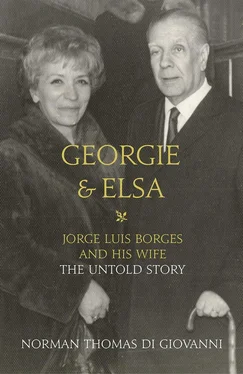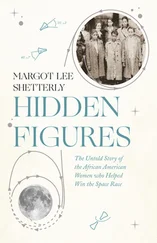These events took place on the eve of Borges’s departure for Harvard University, where, over the following months, he was to deliver the prestigious Charles Eliot Norton lectures. Hitherto a life-long bachelor, Borges was sixty-eight years old at the time of the wedding; Elsa, a widow, with a son in his twenties, was eleven years younger. The trip to Cambridge she described as her honeymoon; as for the lectureship she appeared to look on it as an altogether secondary matter.
The church of their marriage had been built in 1880 in the plain neo-Gothic style of the time and place, the belltower and steeple, with its four pinnacles, towering over the buildings crowded round it. Soon after, in 1883, the edifice was given to the Congregation of the Redemptorists on the day of their first arrival in Buenos Aires. Founded in Italy in 1732, the Congregation is a missionary society whose aim is to put into action Jesus Christ’s command to ‘Love one another as I have loved you.’ In 1884, the Church of Our Lady of the Victories also became a seat of the cult of Our Mother of Perpetual Help, the Byzantine icon of which the Redemptorists are caretakers. Such was the improbable and incongruous setting for the marriage of a man of Borges’s well-known agnosticism and sceptical turn of mind.
In the published pictures of the church ceremony Borges stood staring ahead, hands behind his back, with Elsa on his right and his mother of ninety-one on his left. The church was packed with friends and well-wishers, along with numerous members of the press and their accompanying photographers. The bride wore a black coat-dress, with a pair of long black gloves, and a white turban-like hat with a short, gauzy veil over thick false eyelashes. Neither Georgie nor Elsa looked as if it were the happiest day of their lives. While Leonor appeared solemn, the couple seemed glum.
According to Borges, on the day of their civil marriage his mother told Elsa that to her only a church ceremony counted. The gauntlet had been firmly thrown down at Elsa’s feet.
2. A History of the Romance Contents Cover Title Page Dedication Prologue: A Figure of Speech 1. Celebrating the Marriage 2. A History of the Romance 3. Off on the Wrong Foot 4. The Norton Lectureship 5. Meeting Borges and Setting Out with a Master 6. Georgie’s Mystery, Elsa’s Bombshell 7. A Visitor and a Yard of Ale 8. Vietnam, Olga, and Harvard Square 9. Borges on Tour 10. Invitations and Goodbyes 11. Interregnum 12. Arrival 13. Settling In 14. The Recoleta 15. Cracks in the Façade 16. Oklahoma and the Fur Coat 17. Hobnobbing with the Rockefellers 18. New York and the Fur Coat 19. Buenos Aires and the Fur Coat 20. Silent Sufferer 21. An Aside 22. The Breaking Point 23. The Reckoning 24. Amongst the Lawyers 25. The Night of the Oxford Martyrs 26. Escape to Córdoba 27. The Mosquito and the Judge 28. The Salem Mystery Solved 29. Return to Maipú 30. Looking Back Epilogue: Ave Atque Vale A note on Borges Picture Section Copyright About the Publisher
There is no definitive account of the romance – early, middle, or late – between Georgie and Elsa. Dates are absent or contradictory, and the resulting picture is full of gaps and distortions. There are her versions of events but little from Borges’s side except for some brief remarks he once made to me about why he married her. (His explanation smacked at one and the same time as overly literary and foolishly romantic.)
Elsa recalled their initial meetings in a rosy and seemingly sincere way while she and Borges were married but after they separated her emphasis changed. She now glossed over those early days and spoke more of their life together. In her recollections of both times there are false notes and plain untruths, especially when she describes the latter years. Surprisingly, looking back on the marriage and her relationship with Borges in 1983, when she was seventy-two and Borges still had three years to live, she expressed neither bitterness nor resentment nor recriminations. In fact, she presented a blissful, storybook picture of their entire married life that had little to do with reality. For some unknown reason she was putting the best possible face on events that had not been pleasant for her.
So what we have is a series of fragments, many of them unreliable. In the maze and tangle of what really took place in the romance – somewhere – lies the irreducible truth. By now, however, that truth is elusive if not irretrievable.
The story begins, according to one Elsa version, which she recounts with girlish enthusiasm and hints of prophetic significance, when she was seventeen and Borges twenty-eight. That would have made it 1927. (Other accounts give their ages as twenty and thirty-one, but for a moment let’s follow Elsa’s lead.)
She grew up on the fringes of La Plata, then a pleasant university town and capital of the Province of Buenos Aires, an hour or so southeast of the city of Buenos Aires. The university was renowned for its distinguished faculty, its important library, and a celebrated Natural History Museum. Founded in 1882, La Plata was carefully laid out on a grid plan; it had intersecting diagonal avenues and it boasted impressive woodlands and parks and public buildings. Elsa remembered it sentimentally as ‘a beautiful, never-to-be-forgotten city, fragrant with its lindens.’
She described herself at the time as una jovencita vistosa – an attractive young woman. One day she accepted an invitation from Pedro Henríquez Ureña, an outstanding scholar and literary figure, to have tea that afternoon at his home. Some young writers from Buenos Aires had also been invited, among them – fatefully – Borges. ‘I say fatefully’, Elsa recounted, ‘because I did not want to accept the invitation. I no doubt had another engagement, which I did not want to break.’ She arrived at Henríquez Ureña’s in a bad mood and took her good time about entering the room where the others were gathered. She claimed that from the time she was a small girl she had been in the habit of not speaking when anything or anybody displeased her. (She noted that the habit was one she never lost.) So she took a seat in an armchair and did not utter a word. Georgie stared at her, he too speechless. Later he confessed to her that he had been terrified. She claims to have found him a kind, talented, good-looking young man. These last words were an obvious sop to Borges, who was present when Elsa spoke them. If on their first meeting both were tongue-tied, she could hardly have judged his kindness or his literary talent. As for his looks, Borges in the twenties was decidedly unprepossessing. At one point he wore thick spectacles that greatly magnified his eyes, and his right eyelid drooped. Later he began to put on weight and grew a beard. In all these stages he was extremely awkward in the presence of the opposite sex. Elsa had been upset on the day because she’d had to give up a date with some other man. Yet if there is any truth to her stories something must have been in the air, for she mentions that many pleasant afternoons were to follow, both in La Plata and in Buenos Aires, and she names the different tea shops she and Borges frequented.
Another version of events states that Henríquez Ureña had invited Elsa and her sister Alicia on a sort of blind date to a lecture at the Museum of Fine Arts. The speaker turned out to be Néstor Ibarra, who was one day to marry Alicia. The young man who’d accompanied him to La Plata was Borges. Elsa is quoted as saying that ‘after Henríquez Ureña introduced us we had tea at the Jockey Club, and the next week Alicia and I went to Buenos Aires, where we all met up. From then on Borges never left me alone. He pursued me night and day. It was on our first date that he swore his eternal love for me.’
Читать дальше












